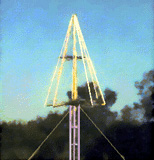
Photo from wikipedia
Abstract The relationship between aerosol concentration and lightning is complex. Aerosols can act as cloud condensation nuclei, contributing to the formation of cloud droplets, cloud electrification and lightning, while high… Click to show full abstract
Abstract The relationship between aerosol concentration and lightning is complex. Aerosols can act as cloud condensation nuclei, contributing to the formation of cloud droplets, cloud electrification and lightning, while high concentrations of aerosols can contribute to a decrease in lightning due to radiative effects. Meteorology plays a dominant role in lightning activity, distorting the effect of aerosols. More measurements, as presented here, are needed to establish the complex relationship between aerosols and lightning. The Po Valley, a heavily industrialized region, was highly affected by the COVID-19 lockdown. The reduction of non-essential activities and mobility coincided with a significant drop in pollutant concentrations and lightning. We investigate the relationship between lightning, meteorology and aerosols. We find that the variation in lightning during the lockdown as compared to recent years cannot be fully attributed to meteorology. ~60 ± 10% of the observed decrease is attributed to meteorology, and ~40 ± 10% to the reduction in aerosol emissions.
Journal Title: Atmospheric Research
Year Published: 2021
Link to full text (if available)
Share on Social Media: Sign Up to like & get
recommendations!